|
"Come, O ladies, let us go see the Lord of Srirangam," sang Tyagaraja when he visited Trichy in 1836. I should have known that he was predicting a heritage tour of the area and, sure enough, did one recently with an all-woman audience.
AURA is a women's association in Trichy which does much by way of social causes. It also invites speakers to address its members. I had done so in 2009. That year they decided that I must lead them on a heritage tour of Trichy. I was most reluctant. My knowledge of the town was limited to my going there on holidays. But it had a history that would make any enthusiast's mouth water. And so, as it always happens when I try to get women to see my point of view, I ended up being convinced instead and committed to the tour.
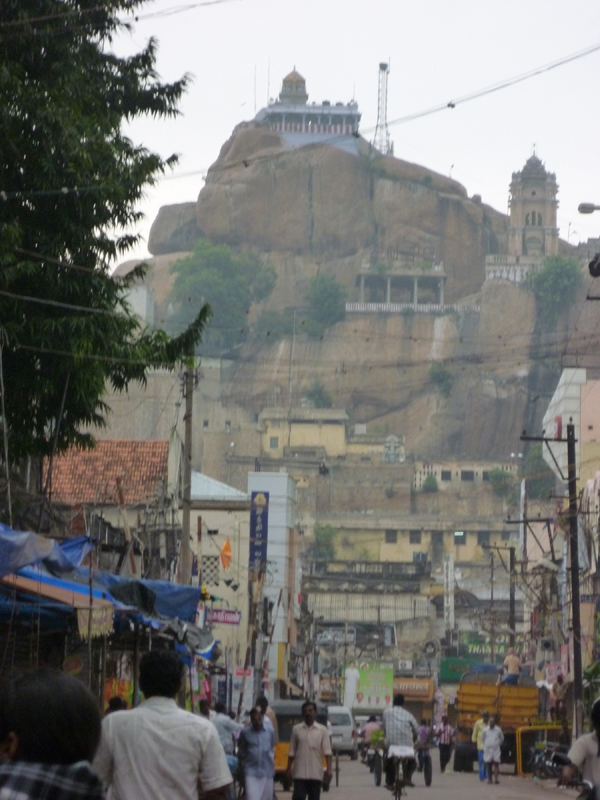
Rock Fort from Theradi Bazaar
|
As Trichy has a story to tell at virtually every corner, keeping time, traffic and temperature in mind, we decided to restrict the tour to the Rock Fort and its environs and within that space to a select dozen locations that would give an idea of what Trichy's heritage was. As I set about researching the locations to visit, I was helped by numerous people, including my parents ("How can you not visit Coronation Park?"), Karthik Bhatt ("What? A tour of Rock Fort without Tawker Lane?") and Dr. Chithra Madhavan ("There are two caves and not one. Try and see the Pandyan cave temple also").
I sent the list of places in advance to the club and the members, together with local enthusiast and trekker Sridhar Bharati, set about identifying them so that we did not have to search for them during the three-hours' morning tour by van and foot.
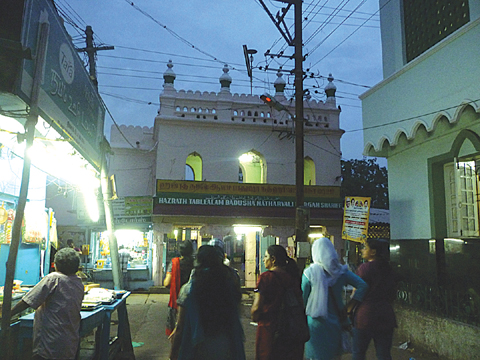
Natharvali Dargah
|
At 6.30 am we were at the Natharvali Dargah. This historic shrine, said to be 1100 years old, is just outside the Rock Fort area. It is the burial spot of Hazrat Dada Nathar Auliya, one of the great Sufi saints. He came from Istanbul and settled in South India, dying in Trichy in 1069 CE. The Nawabs of Arcot particularly venerated Nathavali and there was even a move in their time to rename Trichy as Nathar Nagar. It is significant that three personages from the family – Chanda Sahib, Mohammad Ali Wallajah and Umdat-ul-Umrah – the latter had spent much time in Madras – are buried here.
The next stop was in the shadow of the Rock Fort, this being Nadu Guzili Street. This was the old Gujarati quarter and their connections with the town go back almost 600 years. Close by is Diamond Bazaar, where most of the Gujaratis made their fortune. A lane off Nadu Guzili is Tawker Chattram Lane. This commemorates one of the best-known Gujarati families of Trichy. The Tawkers, almost all of whom had the initial T to indicate that they came from Trichy, were one of the oldest Gujarati families to come South. They were known for their success in the trade and their acts of philanthropy. One of the latter was the Tawker Chattram which stood till recently by this lane. The Tawkers were to establish a powerful presence in Madras by the close of the 19th Century. Their showroom on Mount Road, their residence on Peter's Road (now New College) and their sensational collapse following a sale on credit to the Nizam of Hyderabad in the early years of the 20th Century are all the stuff of legend. Interestingly, a Tawker Chattram still survives in Ayanavaram, close to the Kasi Viswanatha Swami Temple, also built by the Tawkers. As I was relating the story, a middle-aged man joined in to listen keenly. At the end of it he shyly introduced himself. He was Shankar Tawker. That was too good a photo-op to miss and we all posed with him.
From here we walked through streets with names such as Periya Chetty, Sourashtra, etc., and came to Theradi Bazaar Road. The Rock Fort loomed large at one end of it. Here, completely lost among a warren of shops stands Coronation Park, an unbelievably sylvan oasis. Sponsored by the plantain brokers of the Teppakulam area, it is a tree filled park whose foliage is so dense that it remains dark for most of the day. In the evening, birds in their thousands come to roost and the music they make is to be heard to be believed. Strewn about in the park are vestiges of past grandeur – derelict fountains, broken ornamental lights and dried up tanks. In the middle, standing beneath a bower, is a statue of Queen Victoria, which from its floral garlands of recent vintage appears to be in worship! Below the statue is a plaque that states that the park was inaugurated in 1901 by R.H. Shipley, the Collector of Trichy. The park commemorates the coronation of King Edward VII which took place that year.
Just behind the park stands Mangammal's Durbar Hall. An ornate octagonal Indo-Saracenic marvel inside, it is completely hidden by later British additions. This is the Government Museum now. It was yet to be opened for the day when we got there, but a look at the environs gave a hint as to the level of upkeep inside. A long lane separated the Hall from its more modern neighbour and this passage doubles up as a local latrine. We braved it in the hope of seeing the Hall from the rear. But we were in for a disappointment as high walls at the rear hid the Hall from view. A plaque, put up during the Raj and akin to what we see on Chepauk Palace and Clive House (in Fort St George), stated that this had been the Durbar Hall of Mangammal of the Naik Dynasty, circa 1700.
According to local tradition, the Durbar Hall is but a small remnant of what was a much larger palace built by Mangammal's husband Chokkanatha Nayak. The construction was made possible by cannibalising the Tirumalai Nayak Mahal in Madurai when Chokkanatha shifted his capital to Trichy in 1665. When Chokkanatha and his son Rangakrishna Muthu Virappa died in quick succession, it was left to the former's wife, Mangammal, to steer the kingdom through a tough period of 12 years when her grandson Vijayaranga Chokkanatha was a minor. Her diplomacy and determination saw her through several attempted invasions. Sadly, her grandson did not have her vision. His coming of age in 1704 saw Mangammal vanish and it is rumoured that she was starved to death. The grandson did not do much beyond composing songs on Ranganatha in a long reign till 1731. His death saw his wife Meenakshi attempt a Mangammal-like act but that was not to be. Chanda Sahib took over in 1736 and Meenakshi's suicide saw the end of the Nayaks. From then on what happened and how Trichy, along with the rest of the Carnatic, became a part of the British empire is well known.
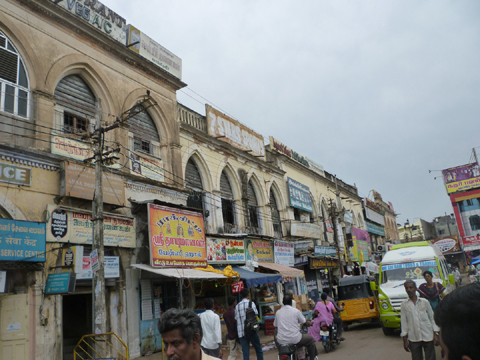
|
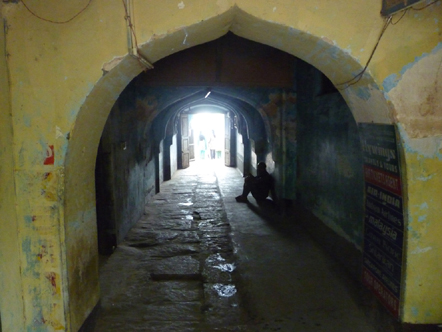
|
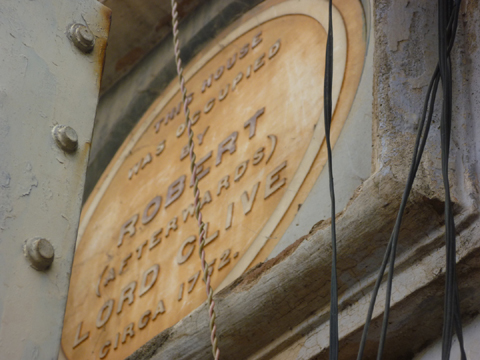
|
|
Clive Hostel Façade
|
Clive Hostel Passage
|
The plaque marking where Robert Clive stayed.
|
The town was to, however, play a key role in this takeover, for the siege of Trichy in the Carnatic wars was when Robert Clive displayed his mettle. Clive Hostel, nestling at the foot of the Rock Fort and facing the Nayak-built temple tank, is today synonymous with a warren of shops long straggling neo-Gothic facade fronted by it. A marble plaque, similar to the one at Mangammal's palace, says that Clive lived here in 1752. What is clear, however, is that Clive must have taken over a Muslim nobleman's residence when he came to Trichy.
The shopping arcade can be architecturally divided into two parts. The lower level is a series of arches in Islamic style, with a central passageway that leads to a vast open courtyard. A Naubat Khana as in Amir Mahal would have probably topped this structure, and drums would have been beaten there on ceremonious occasions. This upper storey must have later made way for the Gothic structure that was later commercialised. All this is the property of St Joseph's College, whose church dominates the skyline on the other side of the tank. When the college moved to Trichy from Nagapattinam in the 1880s, Clive House became the hostel for its students.
It still remains one. Inside, on three sides of open courtyard are the hostel buildings. The ones on the left and right are new additions. The building at the far end is of earlier vintage. We were assured that this was where Clive lived. But alas, a plaque there gives the date of construction as 1913. There must have been an older structure here that had served as Clive's residence and, no doubt, it was demolished to make way for the hostel a century ago. Whatever be the case, the upkeep of the premises is shocking and even the sole plaque commemorating Clive is ready to fall off, being kept in place by an air-conditioner that hides it from view.

Schwartz's Christ Church
|
On coming out of Clive Hostel, if you walk to your right along the tank, you reach Nandi Koil Street. Here, exactly opposite the Naganatha Swami Temple, is Christ Church, built by the Rev Christian Frederick Schwartz in 1766. It lays claim to being the second oldest Anglican church, built east of the Suez, after St Mary's in Fort St George. The Rev Schwartz is a legend in South Indian history. Known as Schwartz Iyer owing to his piety and learning, he is best remembered as the guardian of the young Serfoji and for waging a ceaseless and ultimately successful battle to get the latter recognised as the rightful Raja of Tanjore.
Schwartz came to India in 1750 as part of the Danish Mission and then moved to Trichy where he set up home in the same premises where Christ Church stands. His home, a single storied building mounted on a high plinth which accommodates subterranean chambers, can still be seen on one side. It was in this house that Schwartz first thought of the Vestry School for the children of officers killed in a magazine explosion in 1763. The Nawab lent a hand in funding it. From 1766, the school functioned from the vestry of Christ Church and became the Vestry School. In 1812 it moved to St John's Church built in the newer cantonment area of Trichy where it still functions. 2013 is its 250th year.
Christ Church has a marble plaque too and it records its date of consecration and also states that the land for the church was donated by the Nawabs of the Carnatic (rather like the way they donated the land for the Kapaliswarar Tank). It is, however, in St.Mary's in Madras that Schwartz is remembered in a huge bas-relief.
The church though kept well, has seen renovation that can only be termed as ill-advised. Polished granite has replaced the old flooring. The memorial stones that lined the floor are now permanently buried underneath. The new granite floor has markings and inscriptions reproduced to indicate whose memorials lie below, but it is just not the same is it? The old wagon-vaulted ceiling (on the same lines as the Mangammal Durbar Hall) has been dismantled and replaced with a flat roof. A false ceiling hides whatever there is on top. A metal spire now tops the church that probably had none to begin with. The stained glass fanlights over the doors have survived intact, thankfully. The altar has been given a new coat of gold paint.
Not far from here is the Bishop Heber School. Established in 1826, it commemorates Reginald Heber, Lord Bishop of Calcutta, who that year died in Trichy while in his bath tub.
Looking down on all this recent history is the immense bulk of the Rock on which a Fort was built at 83 metres in height and said to be over 3.8 billion years in age, it is older than the Himalaya, The Fort is home to a small settlement and the historic temple to Tayumanaswami – Shiva who took the guise of a mother to help a pregnant devotee through her labour. The 100 pillared hall which is half way up has seen umpteen music concerts right through the 19th and most of the 20th Century. Mostly kept locked now and used as a wedding hall on hire, its pillars can tell us a lot of Carnatic music history if only they could. At almost the same level is a unique three-storied bell tower, 19th Century in vintage. It combines elements of Indo-Saracenic and is topped by a Dravidian Vimana!
A road originally used by processional elephants leads half way up to the Rock Fort. A village still exists here. On one side of it is lower Pallava cave, there being an upper one, much nearer the summit. The lower cave, dated to 580 AD is a typical rock-cut shrine with alcoves for deities facing the entrance and two empty sanctums on the extreme left and right. It is thought that these were Jaina caves built by Mahendra Varman which were later converted into Hindu shrines. This also gives credence to the theory that Tirucchirappalli gets its name from Tiru Jina Palli.
The Rock Fort area is in many ways like our George Town. Though a lot cleaner, it faces the same problems of over crowding, unregulated traffic (though a system of one-ways is in place) and rampant demolition of old structures to make way for crass modern showrooms. This 'retail-isation' of the area needs to be stopped at all costs. A huge enclosure at the foot of the rock is said to be the future home of a retail giant in the region, an equivalent to the kind that dominates our T Nagar. There is no list of heritage structures and no protection is afforded to any bar those that are under the ASI. Nobody has any information on the historic buildings that still survive. The area has immense potential for tourism and it will be a pity if it all goes away. Hopefully the women who came on the tour will show the way.
|